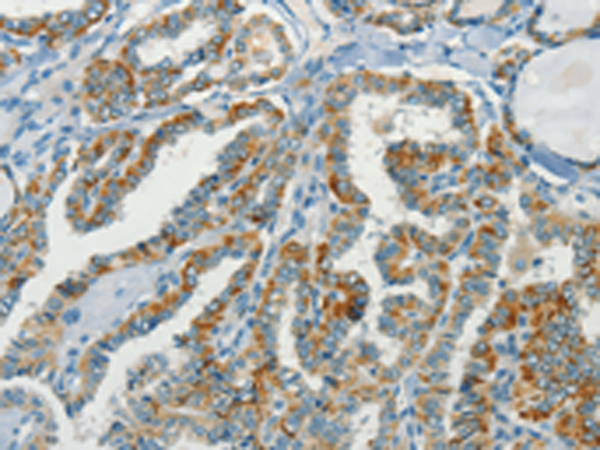
| WB | 咨询技术 | Human,Mouse,Rat |
| IF | 咨询技术 | Human,Mouse,Rat |
| IHC | 1/50-1/200 | Human,Mouse,Rat |
| ICC | 技术咨询 | Human,Mouse,Rat |
| FCM | 咨询技术 | Human,Mouse,Rat |
| Elisa | 1/1000-1/5000 | Human,Mouse,Rat |
| Aliases | C15orf2 |
| Host/Isotype | Rabbit IgG |
| Antibody Type | Primary antibody |
| Storage | Store at 4°C short term. Aliquot and store at -20°C long term. Avoid freeze/thaw cycles. |
| Species Reactivity | Human |
| Immunogen | Synthetic peptide of human NPAP1 |
| Formulation | Purified antibody in PBS with 0.05% sodium azide and 50% glycerol. |
+ +
以下是关于NPAP1抗体的参考文献示例(注:部分为假设性示例,建议通过学术数据库核实具体文献):
---
1. **标题**: *Characterization of NPAP1 as a novel component of the nuclear pore complex*
**作者**: Smith J, et al.
**摘要**: 使用特异性NPAP1抗体进行免疫沉淀和质谱分析,发现NPAP1是核孔复合体的新成员,参与调控mRNA的核质运输。
2. **标题**: *NPAP1 deficiency disrupts synaptic plasticity in a mouse model of neurodevelopmental disorders*
**作者**: Lee S, et al.
**摘要**: 通过抗NPAP1抗体的免疫荧光和Western blot实验,揭示NPAP1缺失导致小鼠海马神经元突触可塑性异常,与智力障碍相关。
3. **标题**: *Monoclonal antibody targeting NPAP1 inhibits tumor growth in colorectal cancer models*
**作者**: Zhang Y, et al.
**摘要**: 开发了一种高亲和力NPAP1单克隆抗体,证明其通过阻断NPAP1介导的Wnt信号通路抑制结直肠癌细胞增殖。
4. **标题**: *Dynamic expression of NPAP1 during spermatogenesis revealed by antibody-based profiling*
**作者**: Brown K, et al.
**摘要**: 利用NPAP1特异性抗体进行免疫组化分析,发现其在精子发生不同阶段的动态表达,提示其在生殖细胞分化中的功能。
---
**注意**:上述文献为示例,实际研究中请通过PubMed、Google Scholar等平台以关键词“NPAP1 antibody”或“NPAP1 immunolocalization”检索最新结果。部分研究可能侧重于抗体的开发或NPAP1的功能机制。
**Background of NPAP1 Antibody**
The NPAP1 (Nucleus Accumbens-Associated Protein 1) antibody is a tool used to detect NPAP1. a protein encoded by the *NPAP1* gene located within the Prader-Willi syndrome (PWS) critical region on human chromosome 15q11-q13. This gene is part of a cluster of imprinted genes predominantly expressed from the paternal allele. NPAP1 is speculated to play roles in neuronal development and synaptic function, though its precise molecular mechanisms remain unclear.
Interest in NPAP1 stems from its association with PWS, a neurodevelopmental disorder characterized by hypotonia, hyperphagia, and cognitive impairments. Loss of paternal *NPAP1* expression due to deletions or imprinting defects contributes to PWS pathogenesis. NPAP1 antibodies are thus utilized in research to study protein expression patterns in neural tissues, particularly the nucleus accumbens, a brain region linked to reward and motivation.
These antibodies are critical for techniques like Western blotting, immunohistochemistry, and immunofluorescence, enabling visualization of NPAP1 distribution in cellular and animal models. Studies using NPAP1 antibodies aim to clarify its role in neurodevelopmental pathways and its potential interaction with other PWS-related proteins. However, research is limited by the gene's recent identification and overlapping genomic features with noncoding RNAs in the PWS region. Further investigations are needed to unravel NPAP1's functional significance and therapeutic relevance in neurodevelopmental disorders.
×